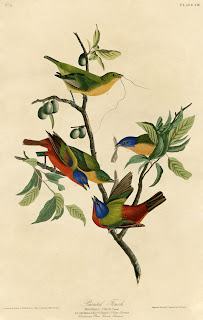n
n
n
n
n
n
n
n
n
n
n
n
n
n
Happy B
Born on this date in 1785 in Haiti, and raised mostly in France, John Audubon always liked nature and especially birds. He came to America at age 18, where he lived on his family’s land and spent time hunting, fishing, drawing, and playing music. He tromped through woods and wilderness, often dressed in frontier clothes and moccasins.
n
n
n
n
n
Audubon’s Legacy
Audubon made a difference in the world, and not just with bird lovers. He influenced other naturalists, such as Charles Darwin, and he influenced taxidermists and wildlife artists, who had previously relied on stiff poses but were now inspired by Audubon’s natural style. Audubon seemed to capture birds mid-action: feeding their young, making nests, catching prey.
After Audubon’s death, the National Audubon Society was formed to conserve wildlife and wild spaces, and many parks and a few towns and counties are named for this artist and ornithologist (bird scientist).
Check out the Audubon Society’s kid pages.
n
n
- n
- Learn about animal tracks, make stamps, do a scavenger hunt, compare flying habits of birds and wingbeats, and more.
n
n
n
- n
- Here are several fun games and pictures to print and color.
n
n
n
- n
- And the Great Backyard Bird Count is a valuable way for amateurs to contribute to science! Notice that there are some fun games, jigsaw puzzles, and activities listed under GBBC for Kids, on the blue side menu!
n
n
Here are some of Audubon’s paintings of birds.
Here is a quickie video about Audubon. Find out why most of the original copper plates from Audubon’s paintings were melted down!Here is a how-to video about drawing a hawk face. The textures this artist achieves with his pencil can help you appreciate some of the techniques that Audubon might have used to achieve his lifelike paintings. (Here is a video that shows a more basic and cartoonish approach to drawing several different sorts of birds.)